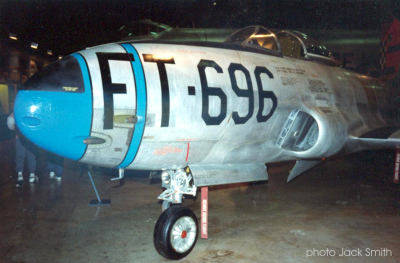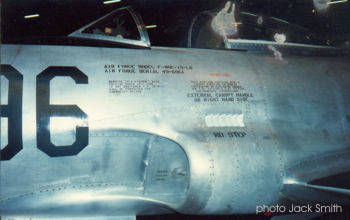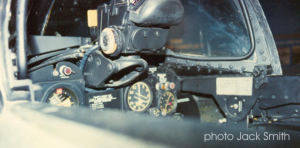|
The USAF Museum: a good home for Uruguayan Air Force 221
by Eduardo Luzardo
photo César Borucki trhough Rodrigo Damboriarena |
|
A visit to the USAF Museum at Dayton,
Ohio, is not only a superb opportunity to observe the development of
aeronautical technology, from the first military Wright Flyer of 1909
to today's Lockheed F-117 Nighthawk |
The
aircraft collection is displayed in the purpose- built hangars and
facilities dedicated to the museum inside the big Wright-Patterson AFB, in
the east central region of the United States. The collection has more than
two hundred aircraft which have served during the history of this air force,
alongside several of their sworn enemies in the conflicts in which they took
part.
The Uruguayan visitor will find, perfectly preserved, one of the three Loening OA-1A amphibians that reached Montevideo in early 1927. They werepart of a flight of five that took off from San Antonio, Texas, as the Pan-American Goodwill Flight. Two of them were lost in an accident when they collided in the air during an exhibition at Argentina. The Loening named San Francisco, piloted back then by the later famous Captain Ira C. Eaker and Lt. Muir S. Fairchild is now housed in the hangar that holds The Early Years Gallery.
In the big hangar dedicated to the jet era aircraft can be found one of the F-100 Super Sabres of the Thunderbirds aerobatic team of the USAF that has visited Uruguay five times since 1954. Uruguayans saw the F-100 first in 1957, flying over the coast of Montevideo after taking off from Buenos Aires (Argentina), but without landing on Uruguayan soil. The Super Sabres returned in 1961, and this time they were received in the Base Aérea N·1 at Carrasco (Montevideo). In addition to the F-100, Uruguayans could see the aerobatics team with their F-84s in 1954, F-4s in 1973, and F-16s in 1992, which all landed at Carrasco. Painted on the side of the cockpit of the preserved plane are the flags of all the countries visited until the first half of the sixties. It's very pleasant for an Uruguayan to see a small reproduction of the national flag among them.
In
addition, the collection of the USAF Museum holds one aircraft that with
thirteen sisters formed the spearhead of Uruguayan military aviation during
what is remembered as the golden era of Uruguayan wings. In the hangar that
houses The Air Power Gallery, near the huge mass of a ten engined B-36 "Peacemaker"
bomber, the Lockheed F-80C Uruguayan Air Force (FAU) registry number 221 can
be found wearing the colors her unit used during her service with the USAF
during the Korean War.
The
F-80C-10-LO serial number 49-696, FAU 221, arrived at Carrasco Air Base on
the 6th of August 1958, along with her sisters numbered 218, 219, 220 and
222. They were assigned to the Grupo de Aviación No. 2 (Caza) stationed at
the Base Aérea No. 1. The Shooting Star, a name seldom used in Uruguay, was
the main combat aircraft of the FAU during the sixties and the last used in
almost all the combat roles. Formations of these beautiful fighters, easily
recognizable due to their wing tip tanks, were a common feature of the
parades on national holidays and other important events, both in Uruguay and
in Argentina. An aerobatic flight was formed with them (Los Cocodrilos), a
clear example of the high level of their pilots. In 1970 the
surviving aircraft were retired from active duty and, wisely enough, 213 was
reserved for the Museo Aeronáutico of Uruguay. Serial 210 was selected to
serve as an ornament for the facilities of the Brigada Aérea I (at Base
Aérea No. 1, Carrasco). Today 210 guards the entrance to the Brigada Aérea
II (at Base Aérea No. 2, Durazno), in the middle of the country. Since the
early eighties this base has been the home of the Grupo de Aviación No. 2,
where nowadays the Escuadrón Aéreo No. 2 (Caza), is equipped with the Cessna
A-37.
Since the
early eighties this base has been the home of the Grupo de Aviación No. 2,
where nowadays the Escuadrón Aéreo No. 2 (Caza), is equipped with the Cessna
A-37.
Meanwhile, in 1970, F-80C 221 (and also 218, destined for the USAF Armament Museum at Eglin AFB, Florida) returned to its homeland, it was specially valued for being a veteran of the Korean Conflict. As with all the aircraft in the museum, the visitor will find in a nearby panel a brief summary of the technical data of the type, as well as the history of the example preserved. About this plane can be read:
"This is one of the few surviving Shooting Stars that flew combat missions during the Korean War. It is painted in the colors of the 8th Fighter Bomber Group to which it was assigned in 1950. After serving with the Uruguayan Air Force during the sixties it was transferred to the USAF Museum in December 1970, where it was restored and displayed to the public in 1979".
| The USAF
Museum is a good home for 221, where more than a million visitors each
year can see her sleek lines (which sister 213 also displays at the
Museo Aeronáutico in Uruguay).
photo Leonel Bianco |
Note: The author would like to acknowledge Mr. Juan Maruri for the information taken from his work "História de la Fuerza Aérea - Volume II", and to thank very specially his brother Néstor Luzardo and his friend Jack H. Smith and wife Dianna, who allowed him to visit the US and the Museum respectively. Thanks also to Dan Hagedorn, Gary Kuhn, Iñigo Artamendi, and Pedro & Fernando Ceróvaz.
Eduardo Luzardo